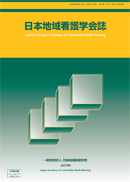Volume 25, Issue 3
Displaying 1-6 of 6 articles from this issue
- |<
- <
- 1
- >
- >|
Research Reports
-
2022Volume 25Issue 3 Pages 4-11
Published: 2022
Released on J-STAGE: December 23, 2022
Download PDF (1255K) -
2022Volume 25Issue 3 Pages 12-19
Published: 2022
Released on J-STAGE: December 23, 2022
Download PDF (1224K) -
2022Volume 25Issue 3 Pages 20-28
Published: 2022
Released on J-STAGE: December 23, 2022
Download PDF (1228K) -
2022Volume 25Issue 3 Pages 29-36
Published: 2022
Released on J-STAGE: December 23, 2022
Download PDF (1225K) -
2022Volume 25Issue 3 Pages 37-45
Published: 2022
Released on J-STAGE: December 23, 2022
Download PDF (1244K)
The 25th Annual Conference of JACHN : Presidential Address
-
2022Volume 25Issue 3 Pages 46-54
Published: 2022
Released on J-STAGE: December 23, 2022
Download PDF (1383K)
- |<
- <
- 1
- >
- >|
